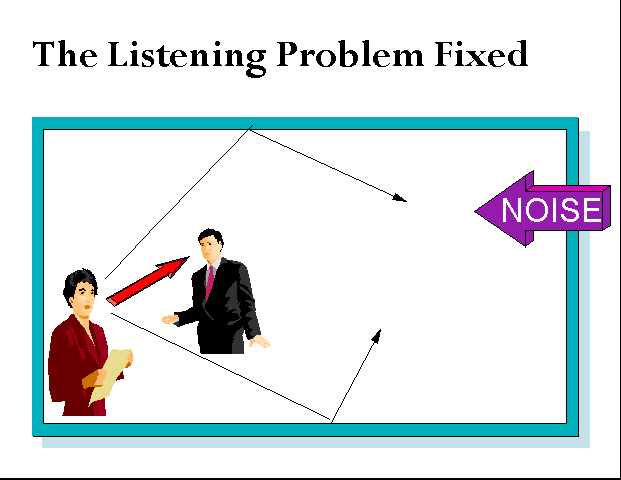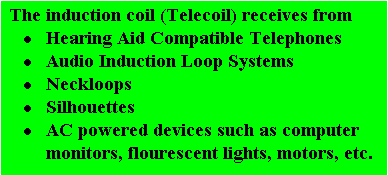 If
Your Hearing Aids Are Not Enough...
A
Presentation by Ron Vickery
If
Your Hearing Aids Are Not Enough...
A
Presentation by Ron Vickery
Narrator:
Many people report that even when using powerful
and sophisticated hearing aids, they are not sufficient in all listening
situations. The Telecoil makes it possible to use a hearing aid with Assistive
Listening Systems and Devices.
Page 1 of 12 [
Top ] [ Next Page
] [ Exit
] 
|
Thanks
for inviting me to this meeting, Ron, but...
What is a Telecoil? |
 |
I thought you would never
ask <G>... A Telecoil is a small induction coil inside a hearing aid.
It is an optional feature on some hearing aids and standard on others. |
It is actuated, or selected,
with the "T-Switch". As an analogy, think of a T-Switch as a selector
switch like on home stereos. Those switches select between tuners, tape
players, CD players, and auxiliary devices. The T-Switch selects either
the hearing aid internal microphone or the induction coil, and by selecting
the induction coil, a large variety of Assistive Devices can be used. So
we ought to call the T-Switch the AD Switch, or ALD switch, or ALS switch,
or maybe the mode switch.
Page 2 of 12 [ Top
] [ Next Page ]
[ Exit
]
|
That's
easy to see, but how does it work?
|
 |
It
works just great!! Oh, you wanted a technical answer! |
An induction coil is just one half
of a transformer. Alternating electric current flows in the primary coil
of a transformer, setting up an electromagnetic field. The field induces
a alternating current in the secondary coil of the transformer. The voltage
and current from the secondary may be higher or lower than the primary,
depending on how the transformer is made. So, an induction coil in a hearing
aid is the secondary of a very loosely coupled transformer. The primary
may be the coil inside a telephone handset, or it could be a neckloop,
a silhouette, or a room size induction loop.
Page 3 of 12 [ Top
] [ Previous Page ] [
Next Page ] [ Exit
]
|
But
how does that make the sound better?
|
 |
It doesn't by itself. I was just talking about how the telecoil gets electrical
signals into the hearing aid. Whether it will be better sound depends on
where the signal is coming from. I think they will talk about that in the
meeting. |
Page 4 of 12 [ Top
] [ Previous Page ] [
Next Page ] [ Exit
]
All wireline phones that you can
buy now days are required to be hearing aid compatible. However existing
phones may not be HAC, and people report that some phones are too weak.
The audio induction loop is a big loop that goes around the circumference
of the listening area. A Neckloop is just a smaller version of an audio
induction loop and it is worn around the neck. The silhouette is an even
smaller version and it fits right up next to the hearing aid. The last
item on the list above represents interference from extraneous sources
- we don't want to hear the radiation from these things and they cause
a problem for some people. The neckloop and silhouette are called induction
coupling devices because they are driven by some other device and provide
a coupling of the device and the hearing aid.
Page 5 of 12 [ Top
] [ Previous Page ] [
Next Page ] [ Exit
]
| Now I'm going to talk about the types of Assistive Devices
that can be coupled to the hearing aid by way of the telecoil. |
 |
Yeah!!
Far out, man. |
Page 6 of 12 [ Top
] [ Previous Page ] [
Next Page ] [ Exit
]
|
The neckloop provides coupling to these things. |
 |
-
Radio Receivers.
(Usually FM) These receivers can be single frequency, tuned to a companion
transmitter, or they could be multi-frequency, which makes them more versatile.
They can also be broadcast band receivers and people can use their neckloop
to hear entertainment and news programs better.
-
Infrared Receivers.
Many public places, such as movie theaters, transmit the audio portion
of the program on light waves. The light wavelength is outside human visible
spectrum, so we call it "invisible light".
Microphone-Amplifier Combos.
These devices are not receivers, although some include FM and Infrared
receivers. They are primarily for one-on-one conversations in noisy environments.
Page 7 of 12 [ Top
] [ Previous Page ] [
Next Page ] [ Exit
]
| The man in this picture is hard of hearing, and he really wants
to hear what she is saying. He gets
her voice directly, as indicated by the red arrow, but he also gets
her voice almost as good but delayed slightly from the walls of the room. |
 |
Another factor affecting understanding
is that some sounds in speech do not carry as good over distance and those
sounds get masked out. A third factor is extraneous noise, represented
by the noise arrow. Noise comes from air conditioning, overhead projectors,
and of course, other people talking. These three factors contribute to
a difficult listening situation.
Page 8 of 12 [ Top
] [ Previous Page ] [
Next Page ] [ Exit
]
| If he was using a FM receiver
with a neckloop and his hearing aids were set for ALD mode, (T-Switch)
and she was using a FM transmitter, then the listening effect would be
as if he moved closer to her. Actually moving closer might be a better
solution, but that is not always possible. The noise level from |
 |
reverberation and extraneous sources
has been reduced. This is just one example. The same principle applies
using any type of Assistive Listening System or Device. His microphone
on his hearing aid is usually turned off and the only source of sound comes
from a microphone very close to the person speaking.
Page 9 of 12 [ Top
] [ Previous Page ] [
Next Page ] [ Exit
]
|
That
was interesting, but could you run that by me again?
|
 |
Maybe
a drawing will help.
|
The dashed line
indicates a direct connection, and the squiggly red line means a wireless
communication path. This shows two examples.
Mic--Transmitter
~~~~> Receiver--Neckloop
~~~~> Telecoil/Hearing
Aid
Mic--Amplifier--Neckloop ~~~~>
Telecoil/Hearing Aid
The next page shows a real life example that
we see everyday on TV.
Page 10 of 12 [ Top
] [ Previous Page ] [
Next Page ] [ Exit
]
Visualize a TV personality interviewing
people on a NYC sidewalk outside the studio. We never see the camera but
we know there must be one, maybe two or three. The camera could be a few
feet from the interview with modern zoom lenses. But what about the
microphone? He does not leave the mic in the studio, or even have it attached
to the camera. He carries a mic and holds it close to the interviewee.
I think the man above is using a wireless mic, but it doesn't make any
difference except for convenience. I remember "the man on the street" radio
interviews, and they used a corded mic like shown above. The important
thing is that the broadcast media knows it has to get good sound and that
means "on mic", or close up sound, rather than "off mic" sound. The same
is true for hard of hearing people using hearing aids. The hearing aid
has a microphone, so it has to be close to the sound source. Assistive
Devices coupled through the telecoil makes it possible to get "on mic"
sound when it is not physically easy to actually get close to the sound.
It doesn't matter if the Assistive Device uses radio, infrared, or is hardwired,
although each system has it's pros and cons.
One more thing that I haven't
mentioned is the "direct connect" type of connection. This is called Direct
Audio Input, or DAI. It bypasses the telecoil with a patch cord that connects
a remote mic or other Assistive Device directly to the amplifier in the
hearing aid. I haven't said much about the big room sized audio induction
loops either. I think that should be the subject of another presentation.
Page 11 of 12 [ Top
] [ Previous Page ] [
Next Page ] [ Exit
]
|
You've
got me interested... where can I get more information?
|
 |
There are
some really good WEB sites that talk about these things. I'll put up a
link to my links page, then how about you and me use our Tele-Coils to
call on the Tele-phone for a Tele Supreme Pizza??
|
my
links page
-- End --
Page 12 of 12 [ Top
] [ Previous Page
] [ Exit
]















